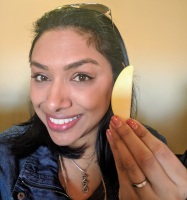
There’s a reason that fellow SciMom Dr. Anastasia Bodnar brought up Arctic apples in the Science Moms movie— “One problem that we’ve had with biotechnology is that people can’t touch it, you know? It’s like, okay, ‘there’s this thing going on but I see no benefit to me.’ Arctic apples and some of the other products on the horizon change all that.”
When it comes to Arctic apples—the non-browning apples created by genetic engineering— it’s easy for the SciMoms to slip into hyper-enthusiasm. We’ve been excited about these apples since well before any of us had the opportunity to taste them, and it’s not only because browned apples aren’t as appetizing as freshly-cut white slices.
How do Arctic apples work?
Here’s how it all works, in a nutshell: When an apple is bumped, bitten into, or sliced, it undergoes enzymatic browning, which is the fruit’s intrinsic chemical reaction to cell injury. Rupturing the apple cells triggers chemical reactions between the enzyme polyphenol oxidase (PPO) and other substances in the cell that, once the reaction begins, leaves behind melanin, causing the apple to turn brown. Interestingly, similar reactions also cause browning in potatoes, avocados, cherries, pears, grapes, lettuce, mushrooms, and more.
Scientists working for Okanagan Specialty Fruits used a technique known as RNA interference (RNAi) to “turn off” a family of four genes that control PPO production in apples by inserting low-PPO-producing genes from other apples. OSF could technically give any of our favorite apple varieties the Arctic treatment, and there are a couple reasons that Golden Delicious was the first variety to receive it. Think back to the mid-nineties, when OSF was founded. Supermarkets only stocked a handful of apple varieties— nothing like the apple selection we take for granted today. In 1996, the not-so-delicious Red Delicious dominated the U.S. apple market, with goldens coming in second. Another reason that goldens were an ideal first choice is that it’s easier to introduce the non-browning trait into some apple varieties than others (in biotech lingo, this is known as transformation. To learn more about the science, regulation, and safety of GMOs, please see our post on this topic).
Keeping cool with Arctic apples
I first covered Arctic apples in 2015, after the Dr. Oz Show featured a segment with Neal Carter, the founder of Okanagan Specialty Fruits and the originator behind applying biotechnology to tackling low fruit consumption and sustainability across the supply chain. Given Oz’s penchant for fear-driven segments—Congress famously chastised the celeb doctor in 2014 for unsubstantiated statements about “miracle” diet supplements—those following the debate around agricultural biotechnology watched with bated breath. So it wasn’t particularly surprising to me when Oz Show guest Michael Hansen, a scientist for the Consumer’s Union, raised concerns about “fraud” in salad bars because, according to him, white apples could fool customers into thinking they’re freshly-cut.
Nevertheless, Carter kept his cool, explaining that only the enzymatic browning of the Arctic apple has been “turned off.” Unlike enzymatic browning, secondary browning occurs when rotting sets in due to bacteria and fungi, which have their own enzymes that cause browning. “It’s important to understand that Arctic apples are just like any other apple in this regard,” Carter explained.
I’ve covered Arctic apples since then, as have other SciMoms, but what first drew me into this fruit’s story was Neal Carter’s assertive yet very human demeanor on the Dr. Oz Show. It also led me to trust that the makers of the first non-browning fruit on the market might actually have the best interests of consumers and growers at heart. But are Arctic apples as cool, quintessentially “apple-y,” and, well, exciting as we SciMoms expected them to be?
I had the opportunity to find out during an (expenses-paid) trip last month to visit Arctic apples’ orchards and facilities outside of Quincy, WA. Here’s some of what I learned:
Arctic apples really are (theoretically) a more “sustainable” fruit
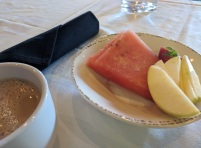
A common argument against non-browning apples is that the trait is unnecessary, since browning seems like a cosmetic issue. This often goes hand-in-hand with concern over food waste and consumer rejection of “ugly” produce— misshapen or otherwise superficially flawed fruits and veggies shouldn’t go to waste, or so the argument goes. Consumers seem to agree enough that Kroger as well as a handful of startups have entered the market for ugly carrots, tomatoes, cucumbers, and more. It’s still not settled how much of an impact “ugly” produce has on food waste and sustainability (for one, it turns out that getting misshapen veggies to market for humans involved added handling costs, and a lot of it is used as cattle feed).
It turns out that the non-browning trait isn’t just cosmetic; it has a direct impact on sustainability throughout the supply chain, as OSF explains in detail on its website. Bruising is a big reason for this— normally, bruises aren’t just cosmetic, but are also a source of waste for growers, packers, and retailers. Notably, bruises in the flesh can allow pathogens to enter the fruit, speeding up the rotting process.
Arctic apple orchards incorporate high tech practices in their growing
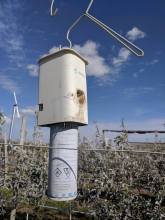
Neal Carter’s enthusiasm was palpable during the tour as he showed the group of bloggers, reporters, and dietitians how OSF’s orchards operate. For one, they use what’s called “high density apple orchard management” with “super spindle” spacing of trees bred to be shorter, which minimizes the space between trees. Production is estimated at 4 million apples in 2018, which will grow to a projected 20 million next year, and up to 60 million in 2020. (These projections are based on existing U.S. orchards alone. Meanwhile, OSF is currently seeking regulatory approval to grow Arctic apples in Argentina, and to sell them in Mexico.)
OSF also takes a conservative approach to water usage— Ranch Systems monitoring used with drip tape irrigation system allows them to monitor and manage irrigation valves and moisture level through a smartphone or other device.
Water usage isn’t all Arctic growers monitor— they’ve implemented the Semios brand of sensors (in which Neal Carter owns stock), with data points throughout the orchard to inform their management of pests, weather events, and more. For example, the codling moth is one of the major apple pests in Washington, which is known among apple growers as the pest that “puts the worm in the apple.” The sensors can predict their arrival, and trigger a precise release of pheromones from sprayers, which ultimately confuse and repel the insects.
As OSF explains on their website, “[a]ll the water and soil data, in addition to leaf wetness and climate and frost monitoring data, can be sent right to our phones from these sensors, making farming very different from what it used to be!”
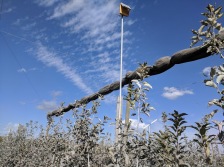
Not all management methods used on Arctic’s orchards are high-tech, but that doesn’t mean they’re old-school either. Netting designed to reduce temperature in the block and provide optimal shade for apple coloring, tree vigour, and prevention of fruit sunburn, can be seen throughout Arctic orchards depending on the conditions and the time of year. Farm Solutions (a Neal Carter and Associates Ltd. company) provides these proprietary fabrics as well as other textiles that can protect orchards from hail damage.
We’re still not sure how “sustainable” Arctic apples are in practice
Arctic apples’ innate potential for sustainability is exciting, though it’s yet to be seen how this will play out as production ramps up and hits more and more supermarkets. For now, their most widely-available product are Arctic ApBitz dried apples— a light, mildly crunchy snack that my daughter loves. We’re curious as to whether there has been more or less fruit waste generated with Arctic apple production so far. With ApBitz in particular, we also wonder if the product is generating less emissions than whole, fresh apples, given the energy that goes into drying and considering the packaging. OSF hasn’t collected this data so far.
From its inception, Arctic’s focus has been on bagged, non-browning slices. They also have plans for other premium cut packaged products, like salad kits, and even apple crisp kits. In theory, premium cut non-browning apple packaged products would be more sustainable than comparable products without the non-browning trait. This sounds like a great way to compete in the booming pre-cut produce market, and a good option for consumers who buy salad kits. Given Arctic’s focus on sustainability, we hope to see whole non-browning apples on the market, too— all of the SciMoms would prefer to buy them this way. Still, it’s worth noting that, when it comes to food waste, a 2013 study from Cincinnati Children’s Hospital Medical Center suggests that children eat 70% more apples and waste significantly less when pre-sliced, and that Arctic slices don’t require the preservatives and non-browning treatments that conventional slices need.
According to OSF, the percentage of whole apples, sliced apples and dried apples they’ll sell in coming years isn’t predetermined, and depends on a few factors including the size of the fruit harvested each year. “[A]s part of our commitment to sustainability and reducing food waste we want to make sure that all apples that aren’t suitable in size for slicing still get to be enjoyed as either whole Arctic apples or Arctic ApBitz dried apple snacks,” OSF said in a statement.
Arctic apples are heading to grocers near you
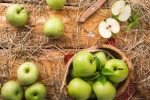 We’ll be keeping our eyes out for Arctic goldens, grannys, and fujis in the coming years as more orchards reach maturity. You can expect to see bagged slices before whole apples. We’ll also keep our eye on regulatory changes to speed up application of non-browning technology to other other apples and fruit like cherries and pears, as well as potential future traits like fire blight and apple scab resistance.
We’ll be keeping our eyes out for Arctic goldens, grannys, and fujis in the coming years as more orchards reach maturity. You can expect to see bagged slices before whole apples. We’ll also keep our eye on regulatory changes to speed up application of non-browning technology to other other apples and fruit like cherries and pears, as well as potential future traits like fire blight and apple scab resistance.
For those who were wondering, rest assured that OSF is well-aware that lots of fans are waiting patiently for them to work with avocado breeders. According to OSF, we may very well see non-browning guacamole become a reality some day.
One thing’s clear to me— after seeing the simplicity of the non-browning golden up close and trying them for myself, I’d love to see browned, bruised apples become a relic of the past.
Additional SciMoms commentary on Arctic apples
- A look into non-browning apples or Arctic apples
- Q&A with Okanagan Specialty Fruits’ president Neal Carter
- Misconceptions continue about the non-browning apples coming to a store near you
- Arctic apple safety: Dr. Oz sows seeds of mistrust on GMOs
- A Tale Of Two Apples: How ‘GMO’ Shapes The Fate Of Your Food


You must be logged in to post a comment.